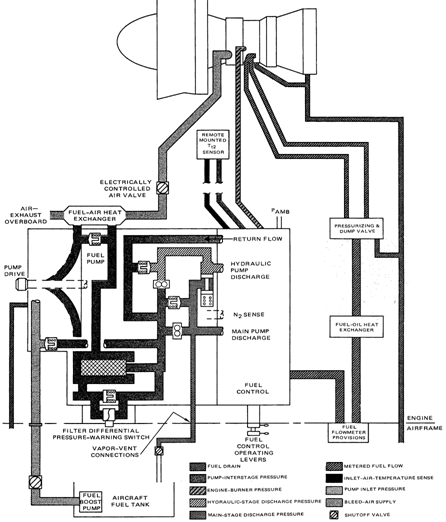Engine fuel control systems:
The thrust of a turbo jet is controlled by varying the amount of fuel that is burnt in the combustion system and in order to operate the safe temperature limits, the amount of fuel that is burnt must be governed by the amount of air that is available at the time. The air supply is dependent upon the RPM of the compressor and the density of the air at its inlet, so under a constant set of atmospheric conditions, the RPM of the compressor is an indication of the engine thrust. The pilot has control of the fuel flow to the combustion system and is able to select any compressor RPM, between ground idling and the maximum permissible which is required for take off conditions, by the operation of a cockpit lever.
In the normal operational environment of an aircraft engine, atmospheric conditions can vary over a wide range of air temperatures and pressures resulting in changes of air density at the compressor inlet. A reduction in air density will cause a reduction in the amount of air delivered to the combustion system at a selected RPM, with a consequent increase in the combustion chamber temperature. If the fuel flow is not reduced, a rise in compressor RPM will occur accompanied with overheating of the combustion and turbine assemblies. An increase in air density will result in an increase in the amount of air delivered to the combustion system at a selected RPM and unless the fuel flow is increased, a reduction in RPM will occur.
Changes in air density at the compressor inlet are caused by:-
a) Altitude. The density of the air gets progressively less as the altitude is increased, therefore less fuel will be required in order to maintain the selected RPM.
b) Forward Speed. The faster the aircraft flies then the faster the air is forced into the aircraft intake. A well designed aircraft intake will slow down this airflow, converting its kinetic energy into pressure energy, so that it arrives at the compressor inlet at an optimum velocity (0.5Mach) with an increase in pressure and hence density. This is known as Ram Effect and plays an important part in the performance of a turbo-jet. Within certain limits the greater the ram effect, the greater the air mass flow and more fuel can be burnt at the selected RPM, producing more thrust.
